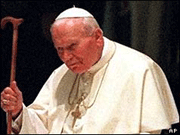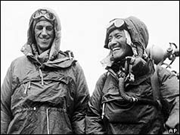May 29
[ 2007-06-07 08:00 ]
 |
| Pope John Paul II is the
first pontiff to visit Canterbury
Cathedral |
| 1982: Pope makes historic visit to
Canterbury |
England have
Pope John Paul II has visited Canterbury Cathedral - the first pontiff
ever to do so.
The Pope was greeted by the Archbishop of Canterbury Robert Runcie and
a crowd of wellwishers who cheered as he arrived by helicopter.
The narrow streets of the ancient city were lined with up to 25,000
people.
They included people from the Pope's native Poland, who waved their
flags along the route.
"How happy I am to be able to speak to you today in this great
cathedral." Pope John Paul II said.
The pontiff told the
congregation of his happiness
at visiting the cathedral, adding that it was a day "which centuries and
generations have awaited".
There was controversy ahead of the Pope's visit as it became clear he
would not use the ceremonial entrance - the Great West door - at the front
of the cathedral.
His bodyguard, Archbishop Paul Marcinkus, had earlier said the pontiff
would use the back door because of "security and tiredness".
John Paul II walked slowly with Dr Runcie to the deanery for a meeting
with the Prince of Wales.
The meeting with the Prince of Wales was followed by a ceremony which
involved the Pope, Dr Runcie and Methodist minister the Rev Dr Kenneth
Greet renewing their baptismal vows together.
The church leaders then greeted all the cardinals and bishops with a
"kiss of peace" before lighting candles for Christian martyrs of different
faiths.
The Pope and Dr Runcie knelt in silent prayer at the spot where St
Thomas Becket was murdered in 1170.
The Pope and Archbishop issued a common declaration, which thanked God
for "the progress that has been made in the work of reconciliation"
between them.
Later in the afternoon, he received a massive ovation from 80,000
people at a mass at Wembley Stadium, billed as the first of his great
"outdoor spectaculars".
The crowd sang "He's got the whole world in his hands" and clapped
their hands as the Pope passed by in his "Popemobile".
Uniformed police surrounded a specially built main altarin the stadium as the Pope said
"peace be with you" and began the mass in front of the huge crowd and
2,500 priests. |
|
|
|
 |
| The two men only stayed
on the summit for 15 minutes |
|
1953: Hillary and Tenzing conquer
Everest | Artificially 1969:
The The New
Zealander Edmund Hillary, and the Nepalese Sherpa Tenzing Norgay, have
become the first to reach the summit of Mount Everest on the Nepal-Tibet
border.
They reached the top of the world at 1130 local time after a gruelling
climb up the southern face.
"A symmetrical, beautiful snow cone summit." Edmund Hillary
said.
The two men hugged each other with relief and joy but only
stayed on the summit for 15 minutes because they were low on oxygen.
Mr Hillary took several photographs of the scenery and of Sherpa
Tenzing waving flags representing Britain, Nepal, the United Nations and
India.
Sherpa Tenzing buried some sweets and biscuits in the snow as a
Buddhist offering to the gods.
They looked for signs of George Mallory and Andrew "Sandy" Irvine who
had disappeared in 1924 in a similar attempt to conquer Everest, but found
nothing.
Then they began the slow and tortuous descent to rejoin their team
leader Colonel John Hunt further down the mountain at Camp VI.
When he saw the two men looking so exhausted Col Hunt assumed they had
failed to reach the summit and started planning another attempt.
But then the two climbers pointed to the mountain and signalled they
had reached the top, and there were celebrations all round.
Careful planning
Col Hunt attributed the successful climb to advice from other
mountaineers who had attempted the feat over the years, careful planning,
excellent open-circuit oxygen equipment and good weather.
Mr Hillary described the peak, which is 29,028 feet (8,847 m) above sea
level, as "a symmetrical, beautiful snow cone summit".
He was one of the members of the expedition led by Eric Shipton in 1951
that discovered the southern route to the top of the mountain.
A year later, Tenzing reached the record height of 28,215 feet (8,599
m) during a Swiss expedition led by Raymond Lambert.
Mount Everest was named after Sir George Everest, the surveyor-general
of India who was the first to produce detailed maps of the Indian
subcontintent including the Himalayas. |
|
| Vocabulary:
|
| |
|
congregation:(教堂中的)会众
altar:
圣坛
|
|